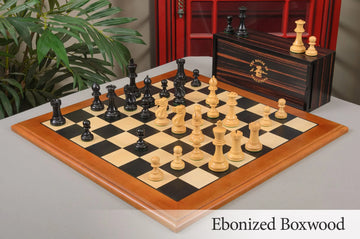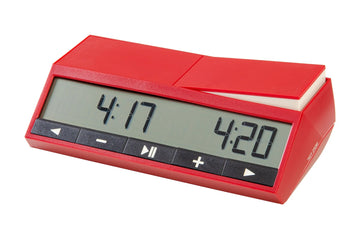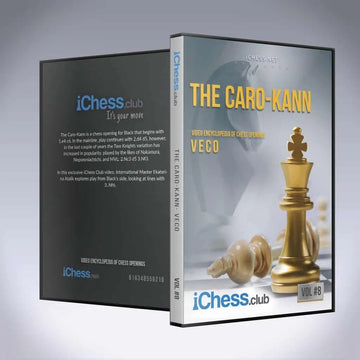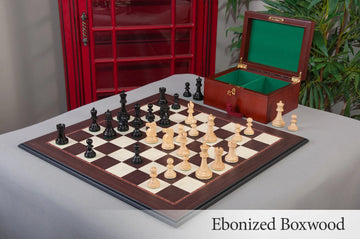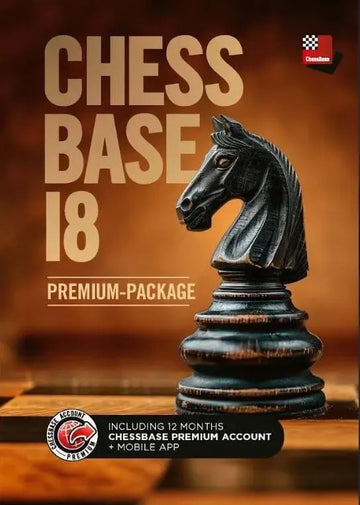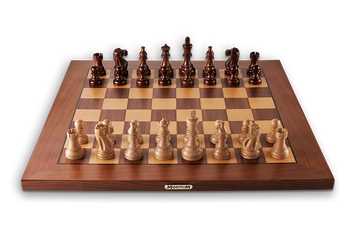The Best Opening vs. 1.e4: The Caro-Kann Defense
'What is the best opening vs 1.e4?' Since the King’s Pawn Opening is the most frequent first move at all levels, it's crucial to know the best way to counter it. From billions of games, statistics have revealed that the highest scoring reply to 1.e4 is not 1...e5, nor 1...e6, but 1...c6 - the Caro-Kann Defense. In this guide, we’ll share the very best way to play the most common lines of the Caro-Kann, as well as proven game plans to convert your advantage into a resounding win!

The Caro-Kann Defense Key Statistics
From over 3 billion online games played at all levels vs. 1.e4, the Caro-Kann Defense came out scoring better than the rest! The average player rating was approximately 1600 Elo.
| Black's Response to 1.e4 | Opening Name | Percentage of Games Played | Points Won Per 100 Games |
| ...c6 | Caro-Kann Defense | 7 | 51 |
| ...c5 | Sicilian Defense | 18 | 50 |
| ...e6 | French Defense | 10 | 50 |
| ...d5 | Scandinavian Defense | 10 | 49 |
| ...e5 | Open Game | 41 | 47 |
Key Themes of the Caro-Kann Defense
Challenging the Center
The fundamental purpose of playing 1.c3 is to provide a supporting pawn for 2.d5. The d5 pawn challenges White’s kingspawn and demands White to defend its center.
A Safe, Reliable Approach
If you’re looking for a safe, solid opening against 1.e4, the Caro-Kann could make a great choice! Instead of gambits and risky attacks, the Caro-Kann provides a steady way to develop a strong position that refutes quick enemy attacks.
Black Plays the Long Game
In several lines of the Caro-Kann, Black plays for a superior pawn structure with a view to winning the end game. A few lines, however, offer White the better pawn structure, in which case you’ll have to go for the middle-game checkmate! In the variations below, we’ll show you the difference.
Caro-Kann Defense in Three Variations
After 1.e4 c6, play normally continues with 2.d4 d5. On move 3., White has three main choices:
Exchange Variation (3.exd4)
In the exchange variation, White simply takes the pawn on d4 immediately. This is the simplest variation to play against since White has just made life easy for you! Just continue with these intuitive development moves:
- Develop your knights to their natural squares (...Nc6 and ...Nf6).
- Pin White’s all-important kingside knight with Bg4 once it has been developed. If you are pushed, trade the bishop for the knight. Only play ...e6 after your light-squared bishop has been developed!
- Move your rook to c8 to control the semi-open c-file.

Middle Game Plan: Minority Attack
Notice how you now have two pawns vs four of White's pawns on queenside. Now, your winning plan is to weaken White’s queenside with a pawn minority attack. Once development is complete, start your minority attack with b7-b5. Learn more about minority attacks at the end of the article!
Top Tip: Look out for chances to play Qb6 to double attack d4 and b2. Just be extra sure it will pay off before blocking your b-pawn advance!
The Advance Variation (2.e5)
Instead of exchanging pawns, White can push its kingspawn to e5. Notice how both of Black’s knights are now prevented from developing and Black appears cramped - hence why the Advance Variation has become so popular.
But there’s no sweat for Black if you know the right moves. An extremely successful counter at club level is the Botvinnik-Carls Defense.
Botvinnik-Carls Defense (3...c5)
- By pushing the c-pawn, Black tests White’s pawn formation while releasing its queenside knight.
- If White takes (dxc5), it leaves both of its pawns undefended. Continue with Nc6 to cover your king from diagonal attacks, and to pressure e5.
- Whenever White plays Nf3, pin with Bg4. Without its protection, White’s central pawns are vulnerable. Capture the knight if you are pushed to.
- Remember that your queenside is quite open! Be careful not to move your queenside knight too early on (even to capture a pawn), otherwise Bb5+ can prove costly.
- 3.c3 is a popular, yet inaccurate move for White. Continue with the same game plan, developing Nc6 and Bg4 to pressure d4. Exchange pawns at an opportune moment, then keep hounding d4.

Game Plan: Attack the Center!
The Botvinnik-Carls Defense is all about undermining White’s over-extended center. Remain committed to this objective until the center is won.
Top Tip: Utilize all your pieces to overcome White’s center! ...Nf5 via e7 is a key idea in most variations, as well as ...Qb6 if White retains a pawn on d4.

Caro-Kann Classical Variation (3.Nc3)
White’s third main option is to defend e4 with 3.Nc3. This traditional approach is also the highest scoring for White. After the pawns are exchanged, White has a considerable space advantage. Black must do something to open up fast!
Tartakower Variation:
- First, exchange pawns on e4 to bring White’s knight out into the center. From here, challenge it with 4...Nf6 to enter the Tartakower Variation.
- After 5.Nxf6 exf6, your dark-squared bishop is set free. On the next move, play Bd6 – the perfect square for your bishop for the game plan ahead.
- Now, castle Kingside and swing your rook to e8 to control the open e-file. It may be crucial later for the mating attack!
- Remember the adage: ‘Knight on f8 – no mate!’ By hopping your knight over to f8 (via d7) your king's fortress is made impenetrable - an extremely high-scoring strategy in this variation!

Game Plan: Middle Game Checkmate
The Classical Variation lends Black a decent position to attack, yet White is left with a superior pawn structure that could prove decisive in the end game. Therefore, Black must try to win before that happens! Your game plan here is a middle-game checkmate.
Top Tips:
- Avoid trading pieces at all costs (for example, don’t trade your bishop for White’s knight on f3 as we did before – but maintain the pin!)
- Direct all of your efforts towards attacking White’s king. A queen-bishop battery to spit fire at h2 works well. Trading a bishop for two pawns on h3 may also pay off. Reinforce the attack with your e8 rook if necessary.

Less Common Variations
Of course, White has other lines that might occasionally surprise you. Here are a couple of the strongest:
Panov-Botvinnik Attack (3.exd4 cxd4 4.c4)
After exchanging pawns on d4 (3.exd4 cxd4), White can slide into a stronger line that’s considered distinct from the Exchange Variation. 4.c4 is known as the Panov-Botvinnik Attack.

Notice how the Panov Variation resembles the Queen’s Gambit. White challenges Black’s central pawn with its c-pawn. Capturing the pawn would only help White develop, so what should you do?
- First, defend d4 with Nf6. Now if White captures, your knight on d4 stands comfortably in front of White’s isolated pawn.
- If White doubles the attack with Nc3, relax. Your d4 pawn is also defended by your queen which could command from d4 unfettered once the knight is gone.
- The highest scoring move here is ...g6: aiming to fianchetto the dark-squared bishop towards White’s fragile d4 pawn. From here, you have a great chance of eventually winning d4 and controlling the game!
Fantasy Variation (3.f3)
Although it's only played in 4% of games, the Fantasy Variation (3.f3) scores very well for White at club level. By defending e4 with the f-pawn, White threatens to regain the perfect center if Black trades pawns.
Opening up the f-file is a more aggressive strategy for White for players who don’t want to be confined to the slow, positional play associated with the Caro-Kann. Yet the 'Fantasy' isn’t without its risks. How can we exploit them?
- Firstly, don’t exchange pawns on e4! After White recaptures, they’ll enjoy the perfect center while regaining the f3 square for their knight.
- Instead, either play safe with 3...e6, or for some extremely dangerous lines, hit back with 3...e4.
- After 3...e4 4.dxe5 Bc5! is treacherous for White. Black follows up with Qb6 and White is forced into clumsy moves like Nh3 to avoid an early checkmate.
- In other lines, look for chances to play Qh4+ attacks whenever White's f3 knight has gone astray.

How to Play the Caro-Kann Defense as White
If you’re a 1.e4 player, you may be starting to feel intimidated by the strength and versatility of the Caro-Kann! Since all of the above variations end well for Black, we’re going to suggest a less conventional line that scores extremely well at club level:
- Start by playing the Classical Variation (3.Nc3). After Black captures, instead of recapturing, pull the rug by gambiting your pawn with 4.f6.
- After Black captures, take back with your knight, and you’re way ahead on development. Black is left stifled on its starting blocks, bar one awkward-looking pawn on c6. Nf6 is Black’s most typical next move.
- From here, begin targeting f7 with Bc4. This cleverly prevents Black’s favorite pin: Bg4. How? 6. Bc4 Bg4 7. Bxf7+ Kxf7 8. Ne5+. White wriggles free from the pin in this classic trick that every chess player should know!
- In other lines, castling kingside and letting your rook join the attack on f7 can often prove deadly.

What is a Pawn Minority Attack?
When discussing the Exchange Variation, we recommended a minority attack on the queenside as your winning strategy. But what is a minority attack, and how to play it?
Luckily, a minority attack is a relatively simple concept to understand. Looking at the example below from the Caro-Kann exchange variation, notice how White has a large group of pawns in an unbroken formation on the queenside (a pawn majority). Facing them, Black has a smaller group of pawns (a pawn minority).
By advancing its pawn minority towards the enemy pawn majority, Black aims to break up White’s strong pawn structure into broken, weaker groups.

After bxc3, whether White recaptures with its b-pawn or with a piece, it must leave either its a-pawn or e-pawn isolated and vulnerable to capture later. The odds just got tipped in Black’s favor!

The Caro-Kann Defense – Is it for You?
The Caro-Kann is statistically the best chess opening for Black against 1.e4 at club level. But that doesn’t necessarily mean it's the best for you! By now, you've probably grasped that the Caro-Kann carries a safe and solid philosophy that’s ideal for prudent, steady players, especially on longer time controls.
On the other hand, if high-octane chess played on the razor’s edge is more your cup of tea, you might prefer learning a gambit where tricks and traps offer Black a rapid road to victory!

